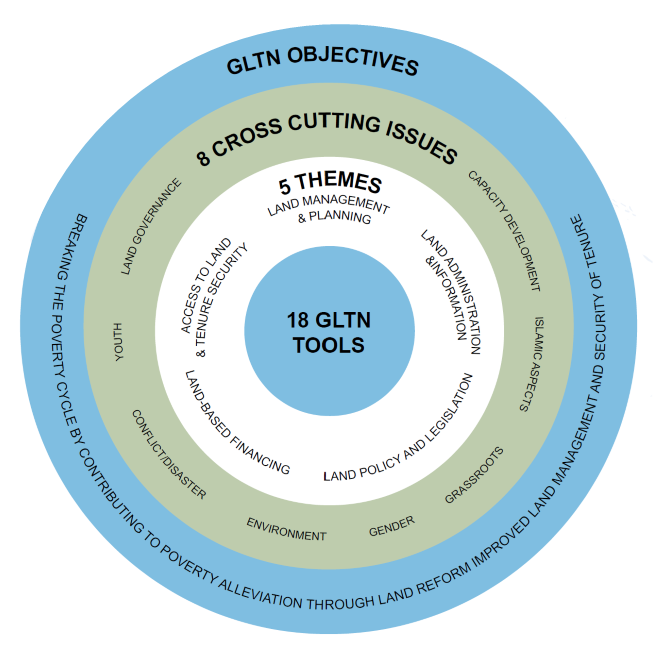
Theme 2: Land Administration and Information
Introduction to Land Administration and Information
Land management is the issue of putting land resources into efficient use, meaning producing food, shelter and other products or preserving valuable resources for environmental or cultural reasons. Land administration is the governmental responsibility to provide security of tenure and information about tenure issues for property markets and governmental and private business activities. For this, information is necessary, which is to be provided by land information systems, sometimes called cadastre. In other words, the government at local and central levels needs to provide an institutional setup including policy and legislation, organisation for implementation of the policy and enforcement of the legislation and dissemination systems to make the information available in society, to benefit tenure security, property markets, land use planning and taxation and business in general.
Tools to support efficient land management and administration will include the establishment of efficient organisations, transparent procedures for decision-making and information technology for collecting, processing, archiving and dissemination of information. To be meaningful, the information needs a geographical component, which will include tools for surveying and mapping and geographical analyses (GIS). The system must be able to produce services to the general public at affordable costs, which means that land users, who will benefit must feel that the fees etc. they have to pay for the services are well worth the value the system is producing for them. This is particular important for pro-poor systems, if improved land administration should be able to contribute to eradication of poverty.
Organisations for land administration can be governmental, which however not disclose private participation in different types of work. The management of the organisation could be independent from the general public administration, e.g. the management can be able to control income and expenditure, staffing and salaries, within a certain frame given by government through a goal-and result-based management system. The responsible officers shall be able to make decisions, based on law without possibilities for political influence. The law should define certain criteria for decision-making, providing room for economic development and also protecting existing rights, whether formal or informal. They should give women and men equal opportunities and protection in owning property. The rules should promote efficient land management, and protect environmental and cultural values. Appeal against decisions shall be made to courts, which are specially designed for land administration. Is it possible to develop these kind of organisations? Questions for tool developers
In order to be available for the general public, organisations can be decentralised. On the other hand, resources are usually very limited and it is costly to build local organisations. Can internet replace decentralised offices also in developing countries?
Computers are very useful for land administration, if the systems are robust, can be maintained and efficiently managed. Data security and archiving issues must be arranged in a very careful manner. How can robust computer systems be developed without being obsolete within a few years?
New techniques for surveying and mapping open possibilities for faster and cheaper survey of land parcels with good quality. GPS makes the surveying procedure much easier but will instead create demands on the establishment of a geodetic framework in order to make coordinates from different systems compatible. Digital photogrammetry and remote sensing facilitate mapping. Is hand-held GPS the answer for cheap surveying technology, which will make it possible to provide land administration for squatter areas?
Land administration can contribute to reconciliation in post conflict areas by providing systems that meet the needs of the people for fairness and social justice. Tools will include new laws, new technology and the establishment of new independent organisations and human resource development. Is a new approach to land administration a necessity for reconciliation in post-conflict areas?
Tool 9: Spatial units
The land parcel of the cadastre is the basic spatial unit used for land registration/recording. Conventionally cadastral systems have supplied spatial information for land administration, spatial planning, billing for cost recovery from services etc. Given that most developing countries have very little cadastral coverage, the emphasis should be on the generation of more appropriate forms of large scale spatial information, rather than on the production of a few accurate cadastral parcels. This is especially where people cannot afford registered rights. New approaches to spatial information are required to upgrade and manage.
It is not possible to use only cadastrally surveyed parcels as the only spatial unit for land management/administration for informal settlements because:-
- The location of informal settlements on privately owned land does not always precisely match the cadastral parcels and is likely to cover many properties in one spatially contiguous unit.
- Often informal settlement takes place on customary land and/or state land, which is generally not parcelled in developing countries;Often the boundaries of the informal settlers ' properties do not accord with the cadastral layout, and this can vary across the settlement and between settlements.
It is also impossible to use cadastrally surveyed parcels as the only spatial unit for land management/administration for rural areas with customary tenure because:-
- The most commonly used geo-spatial references in the rural areas are the administrative units of the country. Agricultural census data, legal regulations, policy and centralized/provincial planning decisions are made in terms of the administrative unit
- Land management decisions are more often taken by socio-territorial units, such as chiefships, clans or extended families, rather than by administrative units. Rarely do the boundaries of the administrative units and those of the socio-territorial areas coincide. Most of the time there is no information on the boundaries of the socio-territorial areas, even at the level of chiefships, as they have generally not been mapped
Often the socio-territorial areas overlap each other, for example there might not be agreement about clan boundaries.
In these situations the parcel of land, i.e. the object on which the rights are exercised, should be defined in a manner other than accurate land surveys and geometrical measurements.
Modeling the relationships between people and land as a basis for land administration and/or land management is of a complex nature. Experiences from practice teach us that it should and can be done in both a computerized and paper based environment, and for formal rights as well as for social land tenure systems (customary, informal). In the development of the Core Cadastral Domain Model (CCDM) efforts have been made to include customary and informal tenures. When trying to answer the question on "who hold/owns what where" a domain model that can be used for a land administration system that can support all forms of land rights and claims, not only registered land rights, will be needed.
The development of a flexible standard for the Social Tenure Domain Model (STDM) is relevant because it can be used as a basis for data and process modeling for software to be used in customary area's and informal settlement areas, or as guidelines for the development of a paper based system. A flexible standard means that it can be extendable and adaptable to local circumstances and it can support both cadastral and non-cadastral approaches. Non cadastral approaches include a move to land management, e.g. for slum upgrading, to manage conflicts or to allocate land to Internally Displaced Persons (IDPs) and refugees. This means that some level of (non parcel based) object identification has to be supported.
In STDM, a person can be a member of a group, a group can be member of a group of groups. A person (natural, non natural), a group of persons or a group of groups can have a one or more rights or socio-tenure-relationships associated, where each right concerns one or more polygons; polygons can overlap or can be identified with a label. A right or socio-tenure relationship is always in between persons and land. A right can be undocumented, in that case the source document is 'no document ' .
Questions for tool developers
- Does the functionality provided in the CCDM really cover the social land tenure system requirements?
- Could it support in the management of geo-information derived from multiple sources for the maintenance of people-land relationships?
- Could it support the delivery of economic and social services to informal settlements and rural areas, including for pastoralists, where there are no cadastral parcels?
- Could the CCDM be recommended to GIS and Database Management suppliers or to 'open-source ' communities as a functional and technical tool to be supported by their software products?
- Could it be used for the land management system representing land records with a minimal spatial component?
- Could it be further specialized to a Social Tenure Domain ModelCan core data and a common infrastructure only be created by using high accuracy co-ordinates?
- Are quick and dirty solutions useful over time and/or incrementally upgradeable?
- How do you manage incrementally altered spatial units in different data bases, which are being changed to increase inter-operability?
Land Administration and Information: Related Publications
- Training Package: Trainers' Guide - Tools to Support Transparency in Land Administration (Eng - 2013)
- Training Package: Toolkit - Tools to Support Transparency in Land Administration (Eng - 2013)
- Land Inventory in Botswana: Processes and Lessons (Eng - 2010)
- Land Records for the Poor: Participatory. Affordable. Credible. Equitable (Brief) (Eng - 2012)
- Designing a Land Records System for the Poor (Eng - 2012)
- Sustaining Urban Land Information: A framework based on experiences in post-conflict and developing countries (Eng - 2012)
- Managing Urban Land Information, Learning from emergent practices (Eng - 2012)


